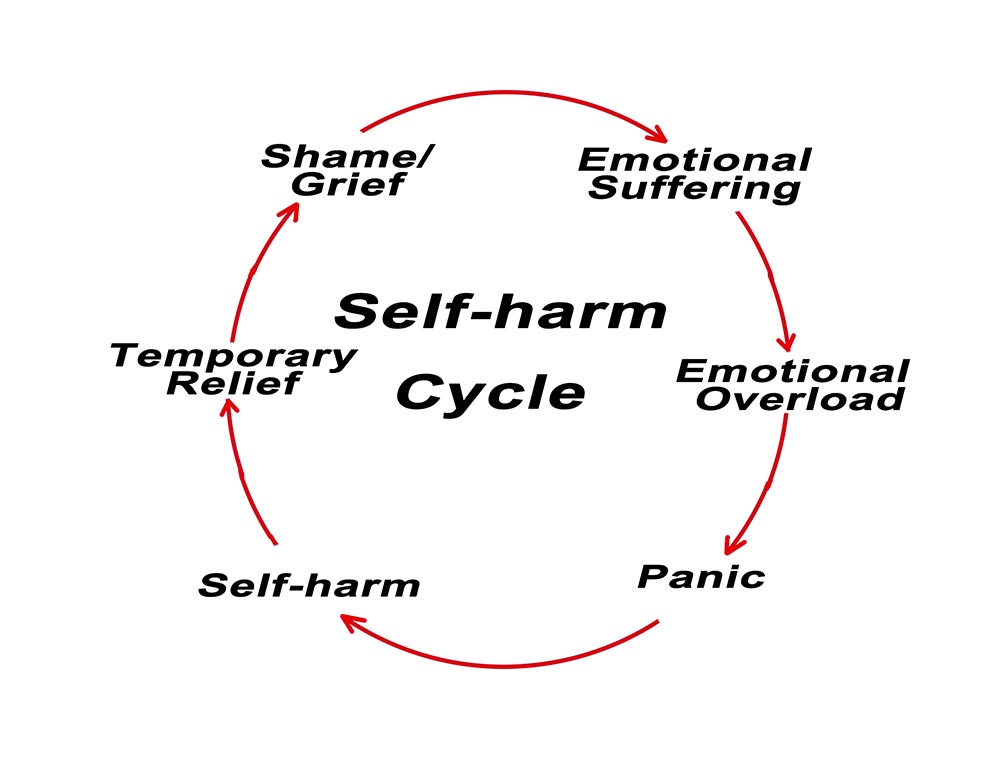When you hear the term self-harm, your first thoughts might be about suicide and suicide prevention. And that’s the first myth about self-harm that needs to be busted: self-harm does not always lead to suicidal thoughts and suicide, but it might. Self-harm, instead of being a mental health disorder or illness in itself, is a symptom of other underlying issues, and suicidal thoughts and tendencies can be among the reasons.
Studies show that self-harm is on the rise globally, and especially among some demographics. While about 17 per cent of all people are likely to engage in self-harm during their lifetimes, the average age of the first incident is 13 years—which indicates that adolescents and young adults may be more at risk of self-harm than other groups. Women are also likely to engage in self-harm and underreport it, and in recent years, people from the LGBTQIA+ community—especially bisexual women—have emerged as another susceptible group.
What’s even more alarming is the fact that even though around 50 per cent of the people who engage in self-harm reach out for help, they do so from friends rather than professionals. While supports from people you trust, like friends, is important when dealing with self-harm or any mental health issue for that matter, reaching out to a professional is even more crucial to prevent the problems from re-emerging in the future. Here is everything you need to know about self-harm.
Understanding self-harm and its link with suicide
There is no standard definition of self-harm, which is why people tend to end up using multiple terms to describe it. This in turn leads to misunderstandings about what self-harm moris. For example, if self-harm only means cutting yourself, then would getting multiple piercings and tattoos qualify as self-harm? No, they wouldn’t. Despite having no standard definition, self-harm is understood to be any behaviour where someone causes harm to themselves, consciously or unconsciously, in order to cope with difficult or distressing thoughts, feelings, and incidents. While it usually takes the form of cutting, many people also engage in activities like burning or taking non-lethal doses of poison, medications or drugs.
According to the study published in Frontiers in Psychology in 2020, titled Understanding the Needs of Young People Who Engage in Self-Harm: A Qualitative Investigation, suicide is not always the intent of self-harm, which is why diagnosing someone with this symptom can be difficult. Many experts categorise self-harm into two parts—non-suicidal self-injury (NSSI) and deliberate self-harm—which this study says is misleading, simply because ascertaining the presence or absence of suicidal intent is next to impossible. It also notes that self-harm can often occur “in a dissociative state so that the person may not be completely aware of what they are doing.”
This is the main reason why self-harm, though often leading to suicides, cannot be considered the same as suicidal tendency. However, self-harm in itself is a critical issue because it always leads to adverse outcomes beyond suicide. It leads to mental health illnesses, poor education and employment outcomes, financial burden (because it’s costly to treat), and an overall low quality of life.

Common causes of self-harm
The Mental Health Foundation (MHF) of the UK reveals that stress is an everyday part of life, and humans have many ways of coping with them. Some find it easier to deal with by talking to family and friends, while others may engage in relaxing activities to de-stress. For others, the pressure created by stress can be quite overwhelming and difficult to deal with even with these coping mechanisms. Some people who experience this overwhelming build-up of pressure can end up turning in on themselves and use their bodies as a way to express the pressure. This is usually when self-harm occurs.
Self-harm usually goes hand-in-hand with extreme feelings of anger, distress, worry, depression, and anxiety—but it’s important to remember that the exact cause of self-harm can vary from individual to individual. Young people are the most affected demographic, and the MHF says the following reasons can trigger self-harm in this category:
• Difficulties at home
• Arguments or problems with friends
• Bullying
• Depression
• Low self-esteem
• Anxiety
• Alcohol and drug use

Warning signs to look out for
Can you ever tell if a loved one is engaging in self-harm? The signs are difficult to spot, but can be identified with a little effort. Any person engaging in self-harming activities may show the following warning signs:
• They may stop participating in regular activities
• They may appear withdrawn, and more quiet or reserved than usual
• They may experience rapid mood changes
• They may get angry or upset easily
• They may show poor performance at work, school, etc even though they usually do well
• They may exhibit unexplained cuts, scratches, burns, etc.
• They may wear clothes that cover their entire body during summers or hot weather
Getting help
If you know somebody who is engaging in self-harm, here are a few things you must do:
• Ask them how they’re feeling, and listen to their answer
• Don’t be judgemental or dismissive
• Be supportive, but don’t reinforce their behaviour
• Acknowledge their pain, but don’t promise confidentiality
• Focus on the underlying cause of the behaviour instead of the behaviour itself
• Do not avoid or change the subject
• Educate yourself about self-harm and spread awareness
It’s very important to remember that self-harm, no matter what its underlying cause, is treatable. Getting help from a professional is of vital importance here, as they can guide you through programmes and therapies that can help you or your loved one recover. Usually, cognitive behaviour therapy (CBT), dialectical behaviour therapy (DBT), and problem solving therapy (PST) are used by mental health professionals to treat self-harm’s underlying causes. These are all non-invasive and non-medication oriented therapies. So, all you need to do is take the first step towards recovery, and reach out.